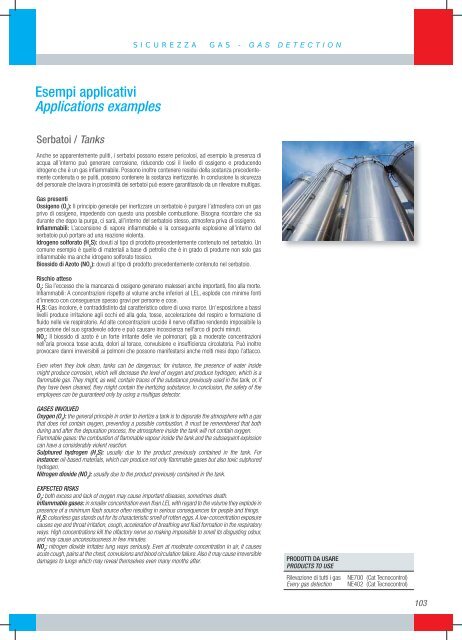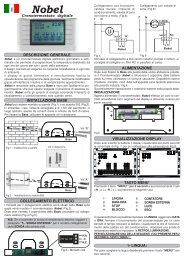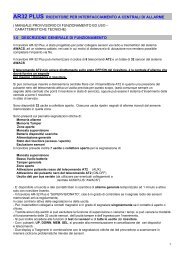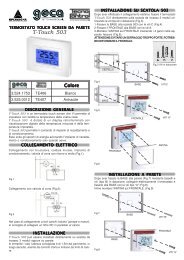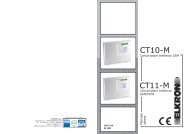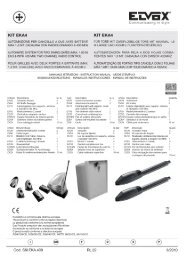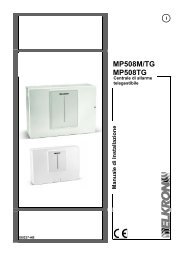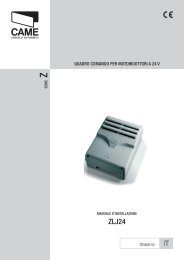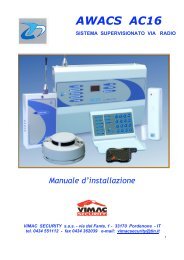Applications examples - Mgelettroforniture
Applications examples - Mgelettroforniture
Applications examples - Mgelettroforniture
You also want an ePaper? Increase the reach of your titles
YUMPU automatically turns print PDFs into web optimized ePapers that Google loves.
SICUREZZA<br />
GAS - GAS DETECTION<br />
Esempi applicativi<br />
<strong>Applications</strong> <strong>examples</strong><br />
Serbatoi / Tanks<br />
Anche se apparentemente puliti, i serbatoi possono essere pericolosi, ad esempio la presenza di<br />
acqua all’interno può generare corrosione, riducendo così il livello di ossigeno e producendo<br />
idrogeno che è un gas infiammabile. Possono inoltre contenere residui della sostanza precedentemente<br />
contenuta o se puliti, possono contenere la sostanza inertizzante. In conclusione la sicurezza<br />
del personale che lavora in prossimità dei serbatoi può essere garantitasolo da un rilevatore multigas.<br />
Gas presenti<br />
Ossigeno (O 2<br />
): Il principio generale per inertizzare un serbatoio è purgare l’atmosfera con un gas<br />
privo di ossigeno, impedendo con questo una possibile combustione. Bisogna ricordare che sia<br />
durante che dopo la purga, ci sarà, all’interno del serbatoio stesso, atmosfera priva di ossigeno.<br />
Infiammabili: L’accensione di vapore infiammabile e la conseguente esplosione all’interno del<br />
serbatoio può portare ad una reazione violenta.<br />
Idrogeno solforato (H 2<br />
S): dovuti al tipo di prodotto precedentemente contenuto nel serbatoio. Un<br />
comune esempio è quello di materiali a base di petrolio che è in grado di produrre non solo gas<br />
infiammabile ma anche idrogeno solforato tossico.<br />
Biossido di Azoto (NO 2<br />
): dovuti al tipo di prodotto precedentemente contenuto nel serbatoio.<br />
Rischio atteso<br />
O 2<br />
: Sia l’eccesso che la mancanza di ossigeno generano malesseri anche importanti, fino alla morte.<br />
Infiammabili: A concentrazioni rispetto al volume anche inferiori al LEL, esplode con minime fonti<br />
d’innesco con conseguenze spesso gravi per persone e cose.<br />
H 2<br />
S: Gas incolore, è contraddistinto dal caratteristico odore di uova marce. Un’esposizione a bassi<br />
livelli produce irritazione agli occhi ed alla gola, tosse, accelerazione del respiro e formazione di<br />
fluido nelle vie respiratorie. Ad alte concentrazioni uccide il nervo olfattivo rendendo impossibile la<br />
percezione del suo sgradevole odore e può causare incoscienza nell’arco di pochi minuti.<br />
NO 2<br />
: Il biossido di azoto è un forte irritante delle vie polmonari; già a moderate concentrazioni<br />
nell’aria provoca tosse acuta, dolori al torace, convulsione e insufficienza circolatoria. Può inoltre<br />
provocare danni irreversibili ai polmoni che possono manifestarsi anche molti mesi dopo l’attacco.<br />
Even when they look clean, tanks can be dangerous; for instance, the presence of water inside<br />
might produce corrosion, which will decrease the level of oxygen and produce hydrogen, which is a<br />
flammable gas. They might, as well, contain traces of the substance previously used in the tank, or, if<br />
they have been cleaned, they might contain the inertizing substance. In conclusion, the safety of the<br />
employees can be guaranteed only by using a multigas detector.<br />
GASES INVOLVED<br />
Oxygen (O 2<br />
): the general principle in order to inertize a tank is to depurate the atmosphere with a gas<br />
that does not contain oxygen, preventing a possible combustion. It must be remembered that both<br />
during and after the depuration process, the atmosphere inside the tank will not contain oxygen.<br />
Flammable gases: the combustion of flammable vapour inside the tank and the subsequent explosion<br />
can have a considerably violent reaction.<br />
Sulphured hydrogen (H 2<br />
S): usually due to the product previously contained in the tank. For<br />
instance: oil-based materials, which can produce not only flammable gases but also toxic sulphured<br />
hydrogen.<br />
Nitrogen dioxide (NO 2<br />
): usually due to the product previously contained in the tank.<br />
EXPECTED RISKS<br />
O 2<br />
: both excess and lack of oxygen may cause important diseases, sometimes death.<br />
Inflammable gases: in smaller concentration even than LEL with regard to the volume they explode in<br />
presence of a minimum flash source often resulting in serious consequences for people and things.<br />
H 2<br />
S: colourless gas stands out for its characteristic smell of rotten eggs. A low-concentration exposure<br />
causes eye and throat irritation, cough, acceleration of breathing and fluid formation in the respiratory<br />
ways. High concentrations kill the olfactory nerve so making impossible to smell its disgusting odour,<br />
and may cause unconsciousness in few minutes.<br />
NO 2<br />
: nitrogen dioxide irritates lung ways seriously. Even at moderate concentration in air, it causes<br />
acute cough, pains at the chest, convulsions and blood circulation failure. Also it may cause irreversible<br />
damages to lungs which may reveal themselves even many months after.<br />
PRODOTTI DA USARE<br />
PRODUCTS TO USE<br />
Rilevazione di tutti i gas<br />
Every gas detection<br />
NE700 (Cat Tecnocontrol)<br />
NE402 (Cat Tecnocontrol)<br />
103


